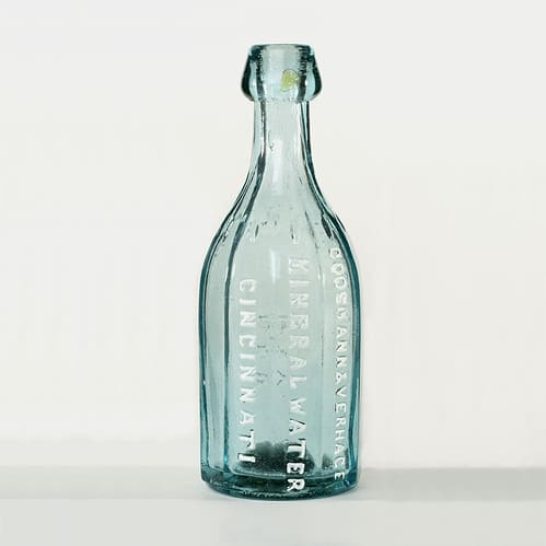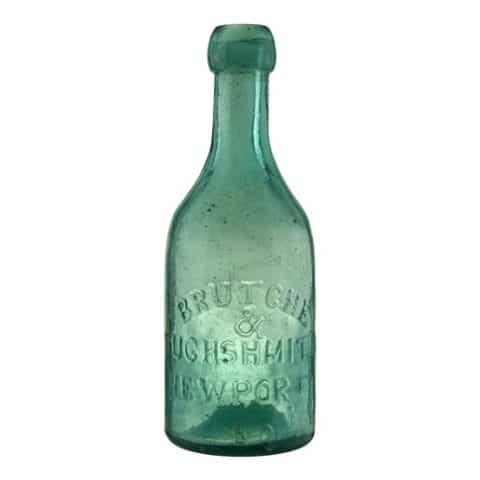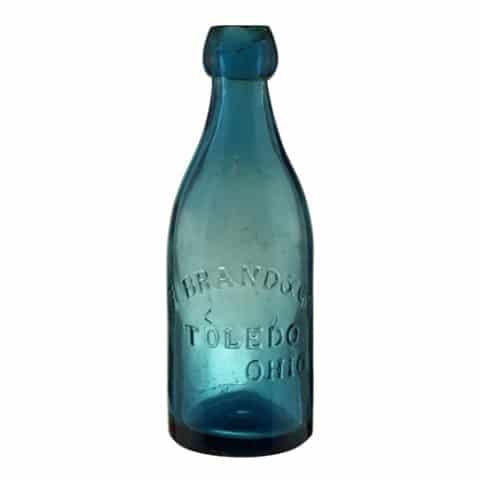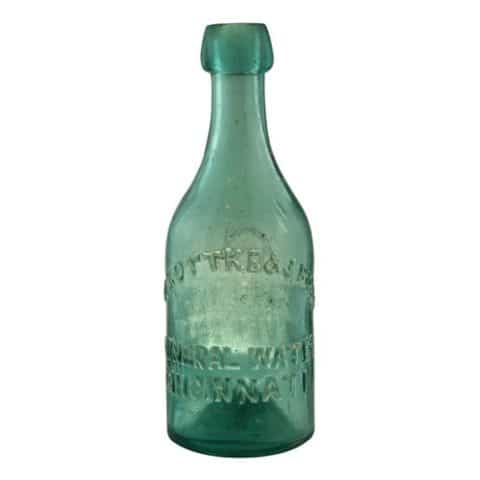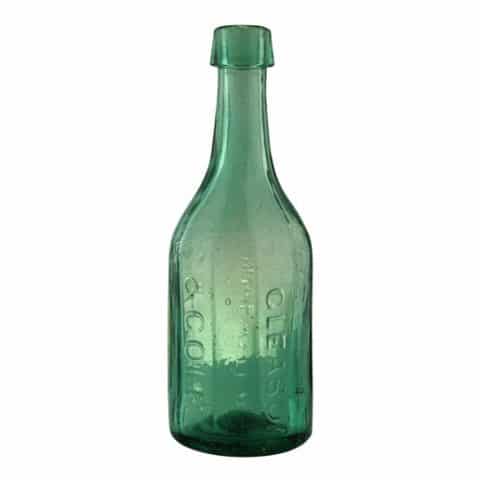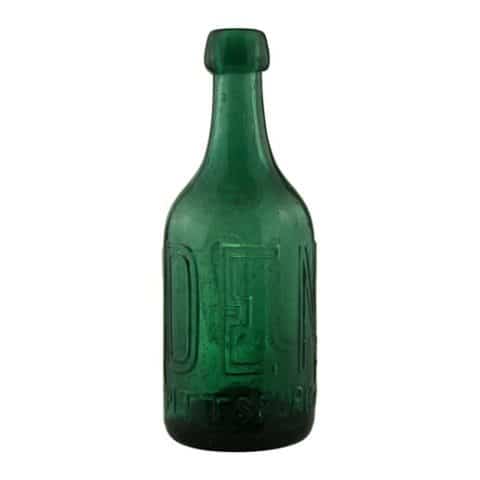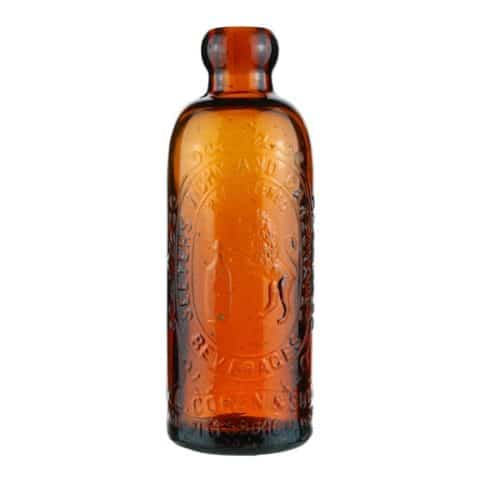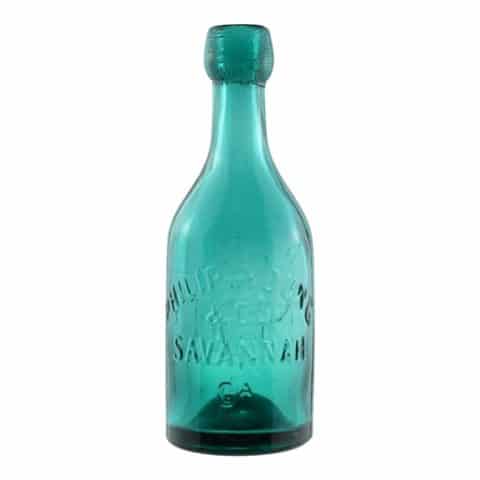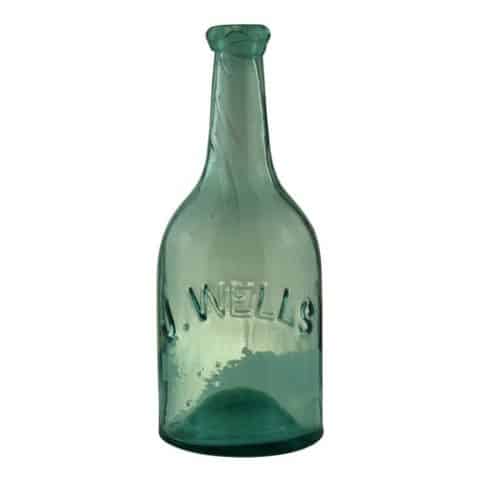H. Verhage – Cincinnati Ohio
H. Verhage – Cincinnati Ohio
This Bottle Is Never Sold
Henry Verhage, Cincinnati, Ohio
Medium Sapphire Blue Soda
Provenance: Doug Shutler Collection

Our medium sapphire blue, blob top pony soda water bottle is embossed ‘H. VERHAGE’ (1st line arch) over the word ‘CINCINNATI’ (2nd line horizontal) and ‘OHIO’ (3rd line flush right horizontal). The reverse side is embossed ‘THIS BOTTLE IS NEVER SOLD’ in two horizontal lines. The bottle dimensions are 7 ½ tall x 2 9/16 wide and 3 ½ wide at the shoulder. The bottle is hand-blown in a two-leaf mold and has an improved pontil with an applied mouth intended for a cork stopper. The soda bottle was ordered somewhere in the early 1860s by Henry Verhage, who was a mineral water manufacturer. The glasshouse is unknown.

Many soda water bottles have extensive base, and side wear as soda water bottles were the property of the soda bottler and were sometimes marked like our example, ‘THIS BOTTLE IS NEVER SOLD’ or similar embossing to that effect.
There are variations of our subject bottle that represent different production runs, partnerships, and glasshouse markings when Henry Verhage was in the mineral water business. Please reference the accompanying support pictures.

Before soft drinks, there was a significant mineral and soda water industry in the United States, populated mainly by regional manufacturers. Water quality was a considerable concern in the antebellum days of cholera epidemics. Mineral or soda water was considered safer than well or other flowing water.
The difference between “soda water” and “mineral water” during the 19th century was often vague. Soda water was generally considered flavored artificial mineral water with the purposeful addition of carbonation and various compounds and flavoring. Mineral or spring water, as it was also called, would generally be natural waters from spring sources that were typically highly mineralized with carbonates like alkaline, sulfurous compounds, and or various salts, which often carbonated naturally. The confusion sometimes arises when mineral water was used as a generic term applied to various natural and artificially carbonated, non-artificially flavored waters, including many utilized for their perceived medicinal qualities. Please visit the museum Spring & Mineral Water Gallery.
In 1851, the mineral water business was very competitive in Cincinnati, as the city was host to eight mineral water factories with 64 employees who produced over one $100,000 in annual output.
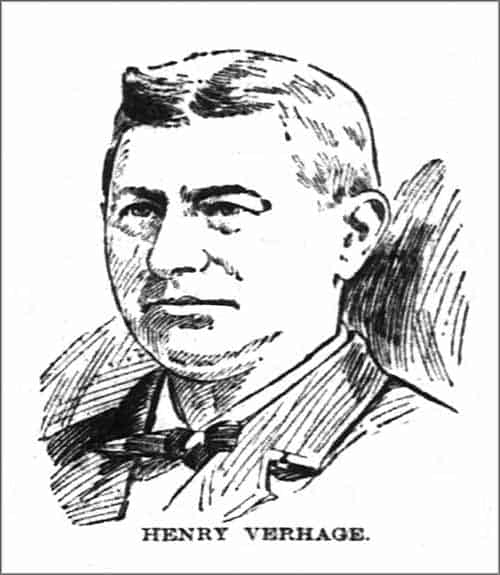
When Henry Verhage died on January 10, 1897, he was 65 years old and one of Cincinnati’s wealthiest and most respected citizens. Verhage was born in Hanover, Germany, in 1830 and came to the United States when he was just a teen.
After Verhage settled in Cincinnati, he first worked in the produce business and followed with a job at a restaurant. He soon went into business on his account by starting a small confectionery and restaurant called the Enterprise Café at the corner of Seventh and Walnut Streets.
Thomas M. Rutherford was among the first mineral water manufacturers in Cincinnati, founding his business in 1845, which was eventually passed on to his son John. Brothers George and John Postel founded another mineral water business at the northeast corner of Lodge Alley and Gano between Walnut and Vine Streets. They were at that location for almost ten years. In 1856, the Postels sold out to Frederick Goosmann, who used his equipment to make his mineral water and root beer. In 1859, Henry Verhage joined Frederick Goosmann in his mineral water business at 65 Gano Street, but Frederick sold out to Henry in 1860.
See our museum example of a Goosmann & Verhage Mineral Water
See our museum example of a Fred Goosmann & Co. Mineral Water
One year later, on October 8, 1861, Henry Verhage married Helen T. Quinn in Cincinnati, and they had four girls and one son.

In the 1863 Cincinnati Ohio City Directory, Henry Verhage was listed as a mineral water manufacturer located at 251 Walnut, so he had moved. He competed with the likes of H. & J. Alweis, Born & Greiwe, G. & H. Muhlhauser, Capt. Henry Niehaus, H. & C. Overdick, Henry Steingraber, Wilke & Co., and Alex M. Berger who were also listed that year in the mineral water business. Henry Verhage took out an advertisement in the 1865 Williams Cincinnati Ohio City Directory saying he was a” Dealer in Cove and Spiced Oysters, Manufacturer of Mineral Water, and Curer of Pigs Feet, Tongues, Tripe, Spare Ribs, etc.” In the 1870 United States Federal Census, his occupation is noted as “Mineral Water & Lead Pipe Factory & Ice Cream Saloon.”
In the early days of pork packing in Cincinnati, the feet and other offal of the animals slaughtered were almost valueless. Henry Verhage saw an opportunity and went into another business of manufacturing this product into palatable and wholesome food, which met with a ready sale in the Southern markets and made him a fortune. Verhage was among the first to introduce the canning of meats and sausage for foreign export, which grew to be a big industry in the United States.
Henry Verhage also had a half-interest in a large lead pipe concern called Merrie & Verhage. With all these varied interests operating simultaneously, none of his affairs were mismanaged or neglected. Everything he touched seemed to prosper.
In 1876, Henry Verhage joined in partnership with Herman Knuwener, who had recently taken over the mineral water business of J. H. Overdick. In the spring of the same year, they moved to much more spacious and convenient quarters at 270-272 Sycamore Street, near the corner of Eighth street, where their business and popularity grew until they had the largest establishment of the kind in the city and the State of Ohio, and probably in the entire west as some accounts stated. They were using steel soda fountains not enjoyed by any other mineral water house in the city. Eventually, they were supplying most of the dealers with soda water. Their business was almost exclusively with city retailers.
With all these business interests, Verhage amassed a fortune and will be remembered for his success in life and his name embossed on quite a few mid-19th-century bottles.
Primary Image: The H. Verhage Cincinnati bottle imaged by the FOHBC Virtual Museum midwest studio by Alan DeMaison.
Support: Reference to Soda & Beer Bottles of North America, Tod von Mechow
Support: Reference to The American Pontiled Soda Database Project, Tod von Mechow
Support Image: HENRY VERHAGE CINCINNATI. Aqua cylinder pony in front of a screen. Sam Greenberger collection.
Support Image: Auction Lot 182: GOOSMANN & VERHAGE MINERAL WATER – CINCINNATI – G&V. America, 1850-1860, Aquamarine, ten-sided with an embossed “teardrop” on each of the paneled shoulders, applied blob colored mouth – iron pontil scar, ht. 7 3/8; (1 ¼” iridescent bruise on side of blob collar), otherwise a bright, sparkling, clean, example). An extremely rare pontiled soda. – John Pastor, American Glass Gallery
Support Image: H. VERHAGE MINERAL WATER – CINCINNATI (Reverse) V – THIS BOTTLE IS NEVER SOLD. 7 ½ x 2 5/8, Manufacturer: Not Known. Material: Glass Design: None. Mold Type: Two Leaf Mold. Form: Cylindrical Edge Design: None Plate Mold: No Shape: Soda – Soda and Beer Bottles of United States
Join the FOHBC: The Virtual Museum is a project of the Federation of Historical Bottle Collectors (FOHBC). To become a member.

